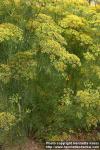 Preparation: Dill Water
Preparation: Dill Water
Related entries: Oleum Anethi.—Oil of Dill.
The Anethum graveolens, Linné. (Peucedanum graveolens, Hiern.)
Nat. Ord.—Umbelliferae.
COMMON NAMES: Dill seeds, Dill fruits.
ILLUSTRATION: Bentley and Trimen, Med. Plants, p. 132.
Botanical Source.—This plant is an annual, bearing large yellow flowers, disposed in flat umbels. It reaches a height of from 1 to 2 feet, and has delicately striated stems, bearing pinnate leaves composed of long, setaceous leaflets. The whole plant is glaucous. The root is long and fusiform.
History.—This plant is indigenous to Southern Russia and other Mediterranean regions; also to the Caucasian territories. It is cultivated in Europe, thriving as far north as the Scandinavian peninsula. It occurs in some sections as a common weed in cornfields. It is cultivated to a very limited extent in this country. It is scarcely used here as a medicine, but enjoys considerable reputation in, England, where it holds a place in the British Pharmacopoeia. It is said to have been known to Dioscorides, and is now regarded as the plant mentioned in the Scriptures (Matt., ch. xxiii, v. 23).
Description.—ANETHI FRUCTUS. Dill-fruit. The seeds are oval or ovoid, seldom longer than 1/5 inch, convex or flattish on one side, concave on the dorsum, which is striated or marked with piliform ridges 5 in number, the two outer ribs becoming blended with the thin, membranaceous margin surrounding the fruit. The 3 central or dorsal ridges are sharply keeled. Six vittae (oil cells), are usually present, 4 between the ribs and 2 on the commissure. The mericarps separate when mature, are about 1/10 inch in width, and of a brown color. The membranous marginal wings are of a yellowish color. The fruit has a strongly aromatic odor and taste. The fruit grown in India is smaller, not so broad, more prominently ribbed, more convex, and the margin less winged. Otherwise it resembles the above described European fruit.
Chemical Composition.—Dill-fruit yields a volatile oil to which its properties are probably due. This oil is obtained to the extent of 3 or 4 per cent, and was found by Gladstone to consist mainly of anethene (C10H16), a hydrocarbon having the odor of lemons, strongly dextrogyre, with boiling point at 172° C. (341.6° F.), and density of 0 846. Two other bodies have also been found (see Oleum Anethi).
Action, Medical Uses, and Dosage.—Carminative and stomachic, and used in the preparation of dill-water. The natives of India use the fruit largely in medicine and cookery. Flatulent colic and singultus, when due to disordered digestion, are relieved by the administration of dill-water or the oil of dill; the former in 1 or 2-drachm doses, the latter in from 2 to 5-drop doses on sugar. It possesses no advantages over the other aromatic seeds.

